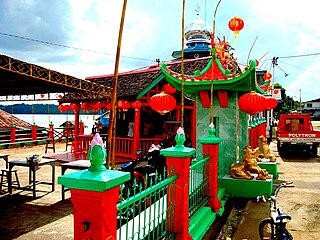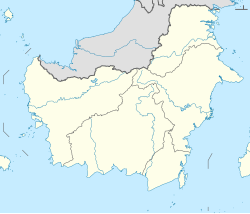
West Kalimantan is a province of Indonesia. It is one of five Indonesian provinces comprising Kalimantan, the Indonesian part of the island of Borneo. Its capital and largest city is Pontianak. It is bordered by East Kalimantan and Central Kalimantan to the east, the Malaysian state of Sarawak to the north, and the Indian Ocean to the west and the Java Sea to the south. The province has an area of 147,307 km2, and had a population of 4,395,983 at the 2010 Census and 5,414,390 at the 2020 Census; the official estimate as at mid 2022 was 5,541,376. Ethnic groups include the Dayak, Malay, Chinese, Javanese, Bugis, and Madurese. The borders of West Kalimantan roughly trace the mountain ranges surrounding the vast watershed of the Kapuas River, which drains most of the province. The province shares land borders with Central Kalimantan to the southeast, East Kalimantan to the east, and the Malaysian territory of Sarawak to the north.

South Hulu Sungai Regency is one of the regencies (kabupaten) in South Kalimantan province, Indonesia. It had an area of 1,804.94 km2, and a population of 212,485 at the 2010 Census and 228,006 at the 2020 Census; the official estimate as at mid 2022 was 232,212. The capital of the regency is the town of Kandangan, which is famous for its culinary ketupat Kandangan.

Kotabaru Regency is one of the eleven regencies in the Indonesian province of South Kalimantan. It consists of two parts; the smaller but more populated part comprises Laut Island, the largest island off the coast of Kalimantan, together with the smaller Sebuku Island off Laut Island's east coast and even smaller islands nearby; the larger but less populated part consists of districts on the mainland of Kalimantan. The regency as a whole has an area of 9,480.17 km2, and had a population of 290,142 at the 2010 Census and 325,622 at the 2020 Census. The official estimate as at mid 2022 was 334,158, of whom 178,660 were in the insular part and 155,498 in the mainland part of the regency. The regency seat is located at the large town of Kotabaru at the northern tip of Laut Island.

Sanggau Regency is a regency in the north-central section of West Kalimantan province of Indonesia. On 18 December 2003, the regency's eastern portion was split off to create a new regency called Sekadau, leaving Sanggau with an area of 12,857.8 km2 (5,000 sq mi). As of the 2020 census, Sanggau Regency had a population of 484,836; the official estimate as at mid 2022 was 492,989. Alongside the Landak, Sekadau, and Sintang regencies, it is one of four West Kalimantan regencies with a predominantly Catholic populations.

North Central Timor Regency is a regency in East Nusa Tenggara Province, Indonesia. It covers an area of 2,669.70 km2, and had a population of 229,803 at the 2010 Census and 259,829 at the 2020 Census; the official estimate as at mid 2022 was 268,067. Its regency seat is located at the town of Kefamenanu, which had a population of 49,095 in mid 2022. The regency borders Timor Leste's Oecusse enclave, one of few Indonesian regions that have a land border with other countries.

Paser Regency is a Regency (kabupaten) within East Kalimantan province in Indonesia, it is the southernmost regency of the East Kalimantan province. Its administrative centre is Tana Paser. It covers an area of 7,730 km2, and it had a population of 230,316 at the 2010 Census and 275,452 at the 2020 Census; the official estimate as at mid 2022 was 280,065 . Before 2007, this regency was formerly named Pasir Regency.

Penajam North Paser Regency is a regency in the Indonesian province of East Kalimantan. Its administrative centre is the town of Penajam. The area which now forms Penajam North Paser was part of Paser Regency until its creation as a separate regency on 10 April 2002. It covers an area of 3,333.06 km2 and it had 142,922 inhabitants at the 2010 census and 178,681 at the 2020 census; the official estimate as at mid 2022 was 183,043. Penajam North Paser Regency has the smallest area among the seven regencies in East Kalimantan province.

Gunung Mas Regency is one of the thirteen regencies of Central Kalimantan Province, Indonesia. The regency seat is located at the town of Kuala Kurun in Kurun District. The population of Gunung Mas Regency was 96,900 at the 2010 census ; and 135,373 at the 2020 census; the official estimate as at mid 2022 was 142,309.

Katingan Regency is one of the thirteen regencies which comprise the Central Kalimantan Province on the island of Kalimantan (Borneo), Indonesia. It was created on 10 April 2002 from what were previously the eastern districts of East Kotawaringin Regency. The town of Kasongan is the capital of the Regency, which covers an area of 17,500 km2. The population of Katingan Regency was 146,439 at the 2010 Census and 162,222 at the 2020 Census; the official estimate as at mid 2022 was 163,989.

Seruyan Regency is one of the thirteen regencies which comprise the Central Kalimantan Province on the island of Kalimantan (Borneo), Indonesia. It was created on 10 April 2002 from what were previously the western districts of East Kotawaringin Regency. The town of Kuala Pembuang in Seruyan Hilir District is the capital of Seruyan Regency. The population of the Regency was 139,931 at the 2010 Census and 162,906 at the 2020 census; the official estimate was at mid 2022 was 166,072.

Malinau Regency is a regency of North Kalimantan Province in Indonesia. It was created on 4 October 1999 from the western districts of Bulungan Regency. The administrative centre is the town of Malinau. The regency is home to the Kayan Mentarang National Park. It covers an area of 38,973.56 km2, and had a population of 62,423 at the 2010 Census and 82,510 at the 2020 Census; the official estimate as at mid 2022 was 85,316. It is the regency with the largest area in the province, as well as the least densely populated. Other than that, Malinau is the only regency in North Kalimantan that is predominantly Protestant and the second most-developed region in North Kalimantan after Tarakan in terms of Human Development Index.

Tana Tidung Regency is a regency within the Indonesian province of North Kalimantan. It is Indonesia's least populous regency, with 25,584 inhabitants recorded in the 2020 census; the official estimate as at mid 2022 was 27,571. Its regency seat is the town of Tideng Pale, in Sesayap District, where 11,280 of the regency's population lived in mid 2022.

Mempawah Regency is a regency of West Kalimantan Province of Indonesia. Originally including a wider area of West Kalimantan, this Pontianak Regency was reduced on 4 October 1999 by the north-eastern districts being removed to form a new Landak Regency, and was further reduced on 17 July 2007 by its southern districts cut out to create a new Kubu Raya Regency. Since 2007 it covers 2,797.88 km2, and had a population of 234,021 at the 2010 Census and 301,560 at the 2020 Census; the official estimate as at mid 2022 was 310,927. The principal town lies at Mempawah.

Melawi Regency is a regency of West Kalimantan province of Indonesia. It was created on 18 December 2003 from part of Sintang Regency. It covers an area of 10,640.8 km2, and had a population of 178,645 at the 2010 Census and 228,270 at the 2020 Census; the official estimate as at mid 2022 was 235,025. The principal town lies at Nanga Pinoh.

Sekadau Regency is a regency of West Kalimantan province of Indonesia. It was created on 18 December 2003 from the eastern part of Sanggau Regency. It covers an area of 6,275.39 km2, and had a population of 181,634 at the 2010 Census and 211,559 at the 2020 Census; the official estimate as at mid 2022 was 214,429. The regency seat lies at the town of Sekadau in Sekadau Hilir District.

Sintang Regency is a regency of West Kalimantan province of Indonesia. It covers an area of 21,638.2 km2, and had a population of 364,759 at the 2010 Census and 421,306 at the 2020 Census; the official estimate as at mid 2022 was 426,416. It is one of the few Indonesian regencies having a land border with other countries. It is also the second largest regency in the province by land area after Landak Regency. The regency was formerly the site of the Sintang Kingdom, a Hindu kingdom that later converted to Islam and which was a regional power in the interior of Borneo Island. The regency seat is located at the large town of Sintang, which is among the biggest settlements in Borneo's interior alongside Putussibau and Puruk Cahu.

Putussibau is an Indonesian town in Kapuas Hulu Regency, West Kalimantan. It sits on the river Kapuas, with the main part of the town located on the right banks, or north, of the river. Officially an administrative village within North Putussibau District, the urban settlement sprawls outside of the primary boundaries to the opposite bank of the river. Official estimates from Statistics Indonesia places the population of the town proper at 12,459 in 2015.
The Dayak Desa War or Majang Desa War was an armed uprising by the Dayak Desa tribe, and later Indonesian nationalists, in West Kalimantan against the Japanese Empire and the Dutch East Indies during World War II. The war was initially caused by the local population's opposition against the rōmusha system and disappointment with Japanese occupation. In the initial phase of Japanese occupation, several Japanese companies entered the region to gain natural resources in order to support the Japanese war effort in the Pacific. Occupying Japanese forced locals to work for free for these companies, mainly in coal mining and timber production. After that, a Japanese foreman working in a company wanted to marry the daughter of Pang Linggan, a respected Dayak chief in the region, which caused more tension between locals and the Japanese. Dayak tribes in the region initiated mangkuk merah ritual, as a sign to mobilise men from villages and prepare for war. The Japanese were driven out of the Borneo interior in June 1945, but returned on 17 July and continued until 31 August 1945 when Japanese forces there surrendered and left the region, replaced by Allied forces including the Dutch, who would later be opposed again until recognition of Indonesian independence in 1949.

Bonar Sianturi was an Indonesian military officer who served as the Regent of Sintang in West Kalimantan from 1989 to 1994. Previously, he served as the commander of the Sanggau Military District from 1986 until 1989.
























